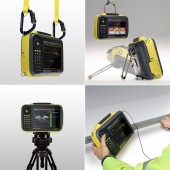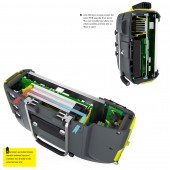Prisma Portable Ultrasonic Flaw Detector by LA Design |
Home > Winners > #27390 |
 |
|
||||
| DESIGN DETAILS | |||||
| DESIGN NAME: Prisma PRIMARY FUNCTION: Portable Ultrasonic Flaw Detector INSPIRATION: A new flexible ultrasonic flaw detector was needed to satisfy a growing market need for enabling technicians to carry out routine detection and analysis as well as more complex inspection procedures with the same product. By embedding three ultrasonic technologies (UT, PA, TOFD) in a compact unit we developed a new multi-functional system. Inspections are often carried out in hazardous, demanding environments, so it was essential that we reduced inspection times by simplifying all aspects of the user interface for both safety and efficiency. The product would need to be easily positioned in a variety of awkward locations. Unlike competitor products, the design of the internal shock absorption allowed greater control over the external surfaces of the product. Hardware components were carefully organised to simplify the architecture and contributed to product styling that was equally sophisticated and rugged. UNIQUE PROPERTIES / PROJECT DESCRIPTION: Prisma is designed for non-invasive material testing in the most extreme environments. It is the first detector to incorporate advanced real-time imaging and 3D scanning, making flaw interpretation much easier, reducing technician time on site. With a virtually indestructible enclosure and unique multiple inspection modes, Prisma can cover all testing applications, from oil pipelines to aerospace components. It is the first detector with integral data recording, and automatic PDF report generation. Wireless and Ethernet connectivity allow the unit to be easily upgraded or diagnosed. OPERATION / FLOW / INTERACTION: The front of the product is dedicated to ergonomic controls and a GUI designed around the technician’s workflow. An intuitive menu system is driven single-handedly by a click-wheel for fast parameter selection. The other hand is free to hold the probe for inspecting. The tactile controls and large colour transflective display provide high visibility in all conditions. Prisma can be easily located in awkward spaces and utilises a multi-position stand and hook, as well as a tripod mount and harness attachments. All removable covers are designed to be accessed without tools by gloved users. PROJECT DURATION AND LOCATION: The project started in February 2011. The product was launched October 2012. FITS BEST INTO CATEGORY: Medical Devices and Medical Equipment Design |
PRODUCTION / REALIZATION TECHNOLOGY: Both waterproof (IP66) and shockproof, Prisma is designed and built to exacting standards using a rigid, shock mounted internal chassis surrounded by an impact absorbing enclosure. As well as shock resistance, the external yellow band increases visibility and defines the physical architecture of the product, containing the major connectors, D-rings and retractable handle. Material application in Prisma is carefully optimised, resulting in the lightest product of its kind on the market. All plastic components are marked to ISO standards for recycling. SPECIFICATIONS / TECHNICAL PROPERTIES: Width 300mm x Depth 90mm x Height 205mm TAGS: Innovation, Rugged, Ultrasonic, User-Centred, Ergonomic, Waterproof RESEARCH ABSTRACT: User insight research was gathered by observing and interviewing a large number of experienced field technicians using Ultrasonic Flaw Detectors. Sonatest sells products to some of the world's foremost companies such as Boeing, Airbus, Shell, Eon and Network Rail. New product requirements were solicited from these stakeholder customers by the Sonatest sales team and competitors equipment was investigated and fully assessed. LA Design has a long working relationship with Sonatest and was able to utilise the experience and expert knowledge of the marketplace. CHALLENGE: Prisma's multi-functionality, both in the technologies it uses and the resulting variety of testing applications and environments, presented significant technical production and product usability challenges. Prisma required a substantial electronic assembly with connectors to suit the different technologies embedded. The enclosure needed to be compact and lightweight, requiring significant cooling but a high level of shock-resistance and waterproofing (IP66). The product had to be positioned into any location and allow the technician a free hand to scan effectively. ADDED DATE: 2013-01-22 09:24:20 TEAM MEMBERS (4) : Pete Holdcroft - L A Design, Matthew Brown - L A Design, Yvan Gosselin - Sonatest and Stewart Lamont - Sonatest IMAGE CREDITS: LA Design , 2012. |
||||
| Visit the following page to learn more: http://www.LA-design.co.uk | |||||
| AWARD DETAILS | |
 |
Prisma Portable Ultrasonic Flaw Detector by La Design is Winner in Scientific Instruments and Research Equipment Design Category, 2012 - 2013.· Read the interview with designer LA Design for design Prisma here.· Press Members: Login or Register to request an exclusive interview with LA Design . · Click here to register inorder to view the profile and other works by LA Design . |
| SOCIAL |
| + Add to Likes / Favorites | Send to My Email | Comment | Testimonials | View Press-Release | Press Kit | Translations |
Did you like La Design's Scientific Instrument Design?
You will most likely enjoy other award winning scientific instrument design as well.
Click here to view more Award Winning Scientific Instrument Design.








